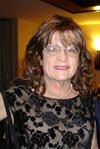

The smart ones go out on the hot floor of Death Valley at day’s end when the sun has lost most of its radiant broil. During the day they stay slithered under sand, inside burrow, tucked in their air conditioned rooms at the Furnace Creek Resort or in the pool at Stovepipe Wells. But in late afternoon, they go out to see the dunes in the long artistic shadows of evening. I see their cars lined up along the roadside some two miles from where I took these pictures, ant-like dots along a path from their colony. My car is among them. From my compass, it bears south-by-southeast. I would use this information if visibility fails. With the air at 117 degrees, they don’t go far from the cool interiors of their vehicles. Some have tripods and big lenses which they aim near the highest dunes on which I stand. Perhaps they see a head at maximum zoom, small with distance, and record the tiny creature far out on a place they consider too hostile for hiking. “This strong wind could get stronger,” I almost hear them; “We could be blinded by blowing sand.”

I came to these dunes a few days ago in early morning when the wind was absent and the air much cooler. No one had walked out here then, and my tracks printed themselves into the sand like first tracks on the moon. The artist was absent then, and I photographed his work. But today I met the artist.
Wind, once theoretical, was forming the dunes before my eyes, and so rapidly that I was surprised to see my tracks disappearing within minutes. I followed my tracks on returning, until, after the picture above, I could find them no more. I was experiencing the dune artist at work. So must gentle Einstein have been surprised when his dreams about space and time flashed over Hiroshima.
Sand blows low to the surface as I walk, its grains too heavy for rising more than about three feet. If it rose much higher its sting could turn blinding. Where a dune drops off on its leeward side, a storm of swirling sand like the turbulence below a waterfall appears frightening, but I avoid these places.

I move over the loose sand, not with athletic speed, but with casual slowness of one experience, informed—not that I really am, but I move that way. I see again the big waves left by wind that had blown several days ago and had sculpted the dunes from a constant direction for a long time, the same big waves I saw before as they lay dormant on the dunes. I see those old waves today, but from another direction come new smaller waves forming in this evening’s wind, gradually eroding away the staid old waves. A new creative voice rings at odds with old established creation. It’s the way of breath, creation and voice, I think.
I hear the artist as he works, softly as if thinking about his next strokes, speaking gentle to my side. Then, when his purpose seems settled, a loud cry, pressing against me, calling me too into action. But I only resist his strong suggestion. I hold my traditional ground, not realizing that all ground, even that which I hold true, is moving. I am beginning to understand that this artist is in control, and I am part of his creation. In his words I live and move and have my being. It might be best if I learn to cooperate.


I keep on climbing the dunes, hoping to ascend the highest one. But the artist is hard at work at this focal point of his sculpture. I reach the last ridge connecting the lower dunes to the highest. To me, it is the south col of Mt. Everest, the final ascent. I stand wide-legged and leaning toward the artist. Then when loose sand gives way in a gust, I fall to my knees where his sting meets my cheek in a flurry, and his voice turns my little space within his picture into a garden of tears. Clearly I can go no further into the life of this intense young artist. He exceeds my ability to empathize and keep up with his innovative thought. Still I want to say to him, “Sing them over again to me, wonderful words of life.”


Is it by these means that I keep people aware of my existence? I wonder if I do this for the pleasure of their surprised and uninformed questions or for the lone pleasure of outdoor extremes. They all seem to find abundantly within their own imaginations enough excitement without coming to places like this. I can argue that mine are real, but I wonder.
Recently, I leaned toward the makeup mirror to inspect my tools and wondered that eye shadow and lipstick, while interesting, no longer thrill like knobby boots, safari shirt, and an Arab cloth held in place over my head with an elastic sweat band. Some people see the years growing behind my eyes, the mouse growing a horse’s mane. Looking past my eyes they might see when love was a slow stately procedure, and now I need this summer increasingly, a yearning like the rising tide about a rock protruding in a calm sea, as definite as a picture in a frame.
The night was still young when I returned to the car, and the gibbous moon was high. I drove again to Badwater to see what happens on the salt flat in the moonlight. I found white holes in the hard black dish, upside down and over me. I took pictures at sixteen seconds and f3.5, and still they are not good. I welcome suggestions.
Usually this kind of insight comes with hindsight after time has diminished the pain.


















































